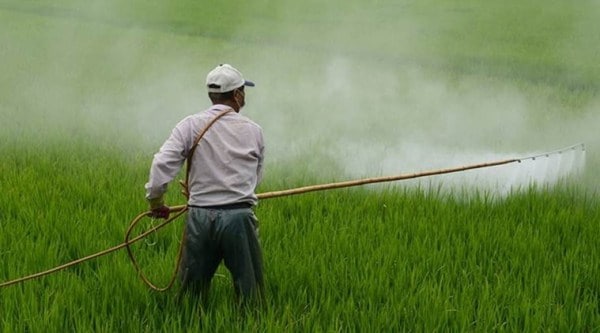- India
- International
Fertiliser sales in May nearly double last year’s, signals agri boom amid overall gloom
Data from the Department of Fertilisers shows all-India nutrient sales at 40.02 lakh tonnes (lt) in May 2020. Not only was this nearly twice the 20.24 lt sales for May 2019, but also more than the 22.61 lt in the same month of 2018.
 Soil moisture apart, fertiliser purchases are also seen to be driven by liquidity with farmers on account of government grain procurement. (Representational Image)
Soil moisture apart, fertiliser purchases are also seen to be driven by liquidity with farmers on account of government grain procurement. (Representational Image)
Retail sales of fertiliser have surged almost 98 per cent year-on-year in May, marking the seventh consecutive month of double-digit growth, and also pointing to agriculture doing relatively well in an otherwise dismal economic landscape.
Data from the Department of Fertilisers shows all-India nutrient sales at 40.02 lakh tonnes (lt) in May 2020. Not only was this nearly twice the 20.24 lt sales for May 2019, but also more than the 22.61 lt in the same month of 2018.
Read| Agriculture an exception, fertiliser sales jump 45% in April despite lockdown
Further, every month since November has posted double-digit increases of sales over the previous year (see table), which is also consistent with the latest quarterly estimates of GDP for 2019-20 released on Friday.

According to the National Statistical Office, the farm sector grew 3.6% year-on-year in October-December 2019, and 5.9% in January-March 2020, compared to 3.5% and 3% for the overall economy in the same respective quarters. The gap between the two was even more in nominal terms after factoring in inflation: 13.9% in October-December 2019 and 13% in January-March 2020 for the former, and 7% and 6.8% in the corresponding quarters for the latter.

“Farmers are buying and we can clearly see demand for fertilisers. Normally, about 70% of our sale to dealers (wholesalers) happens on credit. The credit period extends to 75-90 days for April sales, which falls to 45-60 days in May, 15-30 days in June, and 7-10 days in July as the Kharif cropping season progresses. But this time, only 30% sales have been on credit, with dealers taking material by paying 70% cash upfront. It indicates good offtake down the line from retailers (each dealer supplies to 30-40 of them) and farmers,” the chief financial officer of a leading private sector fertiliser company said.
“Fertiliser demand has been strong right from the rabi (winter-spring) season due to last year’s extended monsoon that helped recharge groundwater aquifers and fill reservoirs to full capacity. Farmers, hence, planted more area. They seem keen to utilise the vastly improved soil moisture, including from this year’s winter and pre-monsoon rain, for the coming kharif season as well,” an executive from a fertiliser cooperative said.
The annual sales growth during April-May was 63.6% for urea (31.17 lt versus 19.05 lt in April-May 2019), 104.8% for di-ammonium phosphate (9.75 lt versus 4.76 lt), 123.7% for nitrogen-phosphorous-potash-sulphur complex fertilisers (11.43 lt versus 5.11 lt), 62.2% for muriate of potash (3.39 lt versus 2.09 lt), 42.5% for single super phosphate (4.59 lt versus 3.22 lt) and 36.8% for compost (0.26 lt versus 0.19 lt).
“The spurt in April sales may have been partly panic-buying. Dealers wanted to stock up, as they feared production and supply disruptions due to the lockdown. Also, there were worries that the weakening of the rupee would lead to prices of imported fertilisers and inputs going up. But the fact that sales have been even better in May, and across all fertilisers, reflects genuine underlying demand. Whether it would sustain in the peak season (June-August) depends on how the monsoon pans out,” another industry source said.
The southwest monsoon arrived on time in Kerala on Monday. The India Meteorological Department forecast rainfall for the country during the four-month (June-September) season to be 102% of the long period average, corresponding to a ‘normal’ monsoon.
Soil moisture apart, fertiliser purchases are also seen to be driven by liquidity with farmers on account of government grain procurement. The Food Corporation of India and state agencies had, as on May 29, bought 354.08 lt of the 2019-20 wheat crop that was harvested after mid-April. Its value, at the minimum support price (MSP) of Rs 1,925 per quintal, would be close to Rs 68,200 crore. In addition, 9.55 lt of chana (chickpea), 6.82 lt of arhar/tur (pigeon-pea), and 6.48 lt of rapeseed-mustard, with a combined MSP value of roughly Rs 11,500 crore, have been procured until now.
“If you include the Rs 2,000 first-installment direct cash transfer to about 8.89 crore farmers under the Pradhan Mantri Kisan Samman Nidhi scheme post the March 24 lockdown, the total money pumped in comes to around Rs 97,500 crore. That liquidity is now getting re-invested in fertilisers and other farm inputs,” the earlier quoted source said.
“My entire 600 quintals of wheat from 36 acres was procured on May 20 and May 22. I haven’t sold my 70 quintals of masoor (red lentil) from 10 acres. Its current market price, at Rs 5,000 per quintal, is above the MSP of Rs 4,800. I intend sowing urad (black gram) in this kharif because it is trading at Rs 7,000/quintal, as against the MSP of Rs 6,000. The government shouldn’t reduce import duties on pulses, and instead allow us to make some money,” Rao Gulab Singh Lodhi, a 60-acre farmer from Nanhegaon village in Madhya Pradesh’s Narsinghpur district, told The Indian Express.
Buzzing Now
May 10: Latest News
- 01
- 02
- 03
- 04
- 05






































